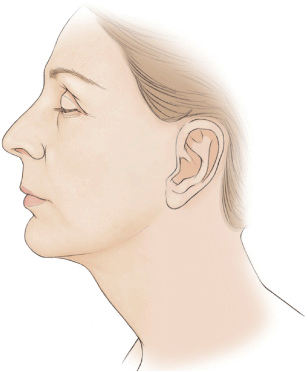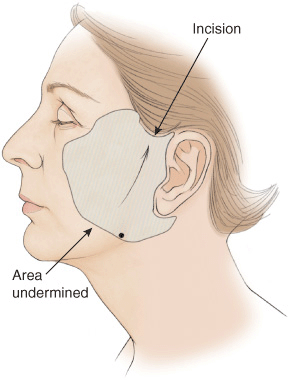Chapter 18. The MACS-Lift Rhytidectomy
Lee E. Edstrom, MD
INDICATIONS
The short-scar technique is ideal for the younger patient, generally between 45 and 65 years of age, who still has some skin elasticity and does not have a lot of redundant neck skin. The suspension technique for superficial musculoaponeurotic system (SMAS) elevation is used whether or not a short scar is used. As described by Tonnard and Verpaele, an ellipse of skin can be excised from the posterior hairline to treat the patient with more neck redundancy.
PREOPERATIVE PREPARATION
Preoperative consultation should determine the patient’s suitability for facial rejuvenation, whether they are adequately healthy and with realistic expectations. Prior facial surgeries, a history of bleeding problems or smoking are necessary to ascertain. Nonsteroidal antiinflammatory drugs (NSAIDs) should be discontinued 2 weeks prior to surgery.
ANESTHESIA
General anesthesia or MAC (monitored anesthesia care, or local with sedation) are suitable for this procedure. Generally patients are sent home after this procedure and MAC facilitates and expedites the recovery. The neck is infiltrated with 30 mL of 0.5% Xylocaine and epinephrine 1:500,000, and 40 mL of the same is used on each side of the face, using a 22-gauge spinal needle to infiltrate and hydrodissect the subcutaneous plane.
POSITION AND MARKINGS
The patient is marked in the preop holding area, where he or she can cooperate in the sitting position. I mark the extent of the cervicomental fat excess, and identify the spot on the malar prominence where the most effective midface lift would be achieved (Fig. 18-1). Marking for ancillary procedures such as fillers is done at this time as well.

Figure 18-1 Maximal malar fat pad mobility.
INCISION AND EXPOSURE
The incision is carried through the sideburn from the anterior hairline to the preauricular skin in a curvilinear fashion (Fig. 18-2), and from there in standard fashion along the preauricular skin crease onto the tragal edge and back out and down to the base of the lobule. It is not necessary to extend the incision behind the ear. Access to the cervicomental fat is done through a single stab wound in the submental skin crease.

Stay updated, free articles. Join our Telegram channel

Full access? Get Clinical Tree








